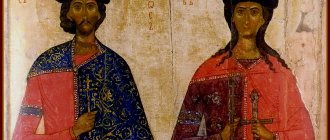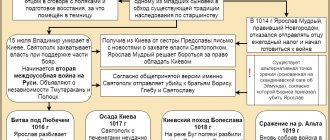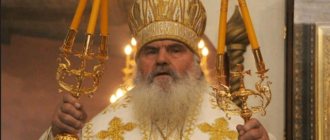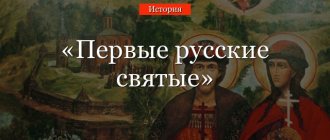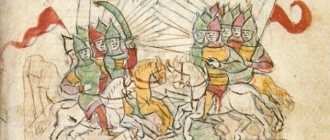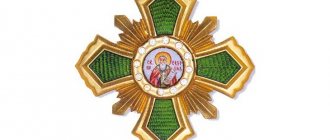Boris Vladimirovich is one of the sons of Prince Vladimir Svyatoslavich from Princess Anna or from an unknown “Bulgarian”, possibly from the Volga Bulgarians. According to official history, he was killed on the orders of his brother Svyatopolk, just as Prince Gleb of Murom was killed after that. Subsequently canonized together with his brother Gleb by the Russian Orthodox Church as passion-bearers - Saints Boris and Gleb.[1]wikipedia
Some of the first monuments of ancient Russian literature are dedicated to the story of Boris and Gleb: “The Legend” of Jacob Chernorizets and “Reading” of Nestor the Chronicler. Many temples and monasteries were built in honor of the brothers.
According to the initial Kyiv Chronicle, he was born of a Bulgarian mother and during the second division of lands he received Rostov as an inheritance, which had previously been owned by his elder brother Yaroslav. Previously, as can be seen from the additions to some lists of chronicles that were in the hands of V.N. Tatishchev, Boris was given by Moore. The second division occurred around 994-996. From this time until 1015 there are no mentions of Boris in the chronicles.
When the devil, the primordial enemy of all that is good in people, saw that Saint Boris had placed all his hope in God, he began to plot intrigues and, like in ancient times, Cain, who was plotting fratricide, caught Svyatopolk. He guessed the thoughts of Svyatopolk, truly the second Cain: after all, he wanted to kill all the heirs of his father in order to seize all power alone. — The Tale of Boris and Gleb
Saint Boris reigning in Rostov
↑ Biography of Boris Vladimirovich
When and where Boris Vladimirovich was born has not been established for certain. Presumably, the place of birth is considered to be Kyiv, 986-989. At baptism he was named Roman - the Christian name was given to the baby by the Venerable Roman the Sweet Singer.
Boris is the ninth, beloved son of Grand Duke Vladimir Svyatoslavich, great-grandson of Olga. Mother - Byzantine princess Anna or Vladimir's fourth or fifth wife - “Bulgarian”. Non-chronicle data point to Milolika.
From a young age he was fond of reading the Holy Scriptures and church works. He was interested in the lives of saints and dreamed of repeating their feat. The aspirations were supported by his younger brother Gleb, with whom Boris had been friends since childhood.
- The father sends his married son to rule in Vladimir-Volynsk. Here, praying brothers, read the lives of the saints and pray for God to grant the same trials. Like their father, they give out alms.
- In 1010, during the second division of lands, Boris was transferred to rule the Rostov principality, which, since 988, belonged to his brother Yaroslav. And Yaroslav, the Grand Duke, sends to Novgorod, to take the place of his deceased son Vysheslav.
- After, until the time of the murder in 1015, there is no information about Boris.
- 1015 - Boris goes to Kyiv to see his sick father, and then to war with the attacking Pechenegs. Having not met the enemy, he returns to Kyiv. Having stopped for the night one day's journey home, he learns that his father has died and his brother Svyatopolk has taken the throne.
- After the death of Prince Vladimir, supporters of Svyatopolk the Accursed freed him from captivity and he took the throne. Fearing claims from his brothers, according to the old tradition, he kills Boris and Gleb. Boris foresaw this murder, but loving his brother, considering him a father and meekly fulfilling the commandments of Christ, he submits and accepts martyrdom, 9 days after Prince Vladimir died. That night only the youths were with the prince, since the squad, having heard Boris’s refusal to conquer Kyiv, dispersed.
- Following the two brothers, Svyatopolk kills another brother - the Drevlyansky prince Svyatoslav.
- The murdered 25-29-year-old Boris Vladimirovich was secretly taken to the Vyshgorod Church of St. Basil and buried there. Twice the relics were transferred to newly rebuilt churches. 1071 is the year the relics were recognized as saints. Since 1240, after the invasion of Batu, the holy relics have been lost.
Domestic and foreign policy
The ruler made considerable efforts to break the dependence of the Russian Orthodox Church on Byzantium, which dominated it. Therefore, in 1054, for the first time in the history of Rus', its church was headed by a Russian, and not a Greek, metropolitan. His name was Hilarion.
Yaroslav the Wise
The internal policy of Yaroslav the Wise was aimed at increasing the education of the people and eradicating the remnants of the pagan faith. The Christian faith was instilled with renewed vigor. In this, the son continued the work of his great father, Vladimir the Baptist.
The son ordered the translation of Greek handwritten books into the Slavic language. He himself loved to read and tried to instill a love of reading and education in his subordinates. The clergy began teaching children to read and write. A school for boys appeared in Novgorod, which accepted its first 300 students.
The number of books grew rapidly and book wisdom became a kind of fashion of the time. It became prestigious to be enlightened.
Library of Yaroslav the Wise
The Tale of Bygone Years talks about a certain collection of books and documents, which is usually called the Library of Yaroslav the Wise. Scientists talk about different quantities: from 500 to 950 volumes. According to some sources, the library was transferred by the prince (according to other sources - by his great-grandson) to the St. Sophia Cathedral.
Since ancient books that are a thousand years old have not been found, there are many hypotheses about where they could be stored. Some claim that these may be the dungeons of the St. Sophia Cathedral, others talk about the catacombs of the Kiev Pechersk Lavra, and still others talk about the Vydubitsky Monastery. But there are also skeptics who believe that the priceless tomes could not have survived the devastating Polovtsian raids and fires.
Another version that has the right to exist is that the Library of Yaroslav the Wise became part of the no less legendary Library of Ivan the Terrible.
Kiev-Pechersk Lavra
Prince Yaroslav the Wise stood at the origins of the emergence of the first Russian monasteries, including the main one - Kiev-Pechersk. The monastery not only made a huge contribution to the promotion and popularization of Christianity and Orthodoxy, but also played a huge role in enlightenment. After all, chronicles were compiled here and books were translated.
And at this wonderful time, “Russian Truth” by Yaroslav the Wise appeared. This is the first set of laws of Rus', which followers added and expanded.
Historians also highly appreciate the foreign policy of the nobleman, in which he also achieved enormous success. It seems that he was the first of the Russian princes to emphasize diplomacy rather than force of arms.
Yaroslav the Wise and his code of laws “Russian Truth”
At that time, dynastic marriages were considered the main way to improve relations with other states. And since Kievan Rus during the reign of the Wise turned into an enlightened and strong state, many rulers of European countries expressed a desire to “marry” with it.
The wife of Yaroslav the Wise was the daughter of King Olaf of Sweden, Ingigerda, who received the name Irina after baptism. From her father she inherited a rich dowry - the city of Aldeigaborg (later Ladoga). The lands adjacent to it were called Ingermanlandia (which translates as the lands of Ingigerda).
Yaroslav the legislator
The prince's son, Vsevolod, married a Greek princess. Two more offspring are among the German princesses. Son Izyaslav married the sister of the Polish prince Casimir, and Casimir himself married the sister of the Wise, Dobrogneva.
The daughters of a Kyiv nobleman had similar dynastic marriages. Elizabeth was married to the Norwegian king Harald, Anastasia - to the Hungarian ruler Andrew. But the most famous and revered was the daughter Anna Yaroslavna, who became the wife of the French king Henry I. As a result of such a foreign policy, Prince Yaroslav the Wise found himself connected by ties of kinship with many powerful neighbors, near and far.
↑ Martyrdom
Prince Boris did not want to go to war against his older brother and refused to violate the holy family relations. Svyatopolk planned to get rid of all rivals - heirs. The Accursed One was more afraid of Boris, whom the people and the squad sympathized with, so he decided to kill him first. The boyars Talets, Elovita and Lyashko, led by Putsha, were sent to do what they had planned.
murder of Prince Boris photo
In the darkness of the night on July 24 (August 6), 1015, the criminals stopped near the tent where the prince was singing psalms. Having waited until he finished praying and went to bed, the killers burst into the tent and plunged spears into the young body. Together with him, they stabbed his servant, the Hungarian George, who had covered the prince with himself.
When Boris was wrapped in a piece torn from the tent, he was still breathing and along the way he tried to raise his head. Svyatopolk, having learned that his brother was still alive, sent two soldiers to finish off the unfortunate man. Boris died, pierced in the heart with a sword.
Boris's killers, who wanted to take away the servant's golden hryvnia, which the prince had given, could not take it off. Then they cut off George’s head and threw him away.
Founding of cities
Prince Yaroslav the Wise founded Yuryev. This happened in 1030, when he went on a campaign to Chud. A new city, named after its angel, appeared on the shores of Lake Peipsi. Now it is called Tartu and is the second largest Estonian city after Tallinn.
City of Yuriev (now Tartu, Estonia)
Another city of Yaroslav the Wise is Yaroslavl, although some historians consider the fact of its founding by the prince not indisputable.
There is another Yuriev, which was founded by a prince. This city turned out to be at the same time a fortress that was part of the Poros defensive line. It was erected to protect Kyiv from nomads. In 1240, the Tatar-Mongols destroyed it, leaving only the ruins of the church. The city was revived around it, receiving the name Bila Tserkva. It is still called that today.
↑ Canonization
Once, above the burial place of the brothers, believers noticed a pillar of fire and heard an angel singing. Afterwards, two miracles happened, after which the people began to venerate princes Boris and Gleb as passion-bearers:
- The stranger accidentally stepped on the grave and his feet were immediately scorched by the fire escaping from the ground.
- There was a fire in the church where the prince brothers were buried. Everything burned, without touching the icons and church utensils.
Metropolitan John I, after doubts, gave permission to open the coffins of the passion-bearers. The coffins were carried into a small wooden chapel, built for the occasion on the site of the burnt church. There the ceremonial autopsy took place. The bodies were untouched by decay and exuded a fragrant aroma.
After some time, two miraculous healings occurred: a lame young man and a blind passerby. After this, Yaroslav builds a new church, where on July 24 (the anniversary of Boris’s death) crayfish with holy relics are transferred. This day is celebrated in the Church as the memory of the brothers - passion-bearers. Presumably, in 1037 the holy princes were canonized, this influenced the strengthening of the independence of the Russian Church. The names of the brothers were given to settlements, newly built churches and monasteries.
Personal life
Many historians agree that Ingigerd’s wife, who became Irina after baptism, had a huge influence on her husband and left a noticeable mark on the history of Rus'. On the lands she inherited from her father in 1703, Peter the Great built St. Petersburg.
In Kyiv, thanks to Princess Irina, the first convent appeared. It was built at the Church of St. Irene. One of its columns “survived” until the mid-twentieth century. Now only the quiet Irininskaya Street reminds of the existence of the temple.
Yaroslav the Wise and his wife Ingigerda
How the personal lives of Yaroslav the Wise and Ingigerda-Irina turned out is difficult to say today. What is known is that 6 sons and 3 daughters were born in her marriage. The wife shared the views of her husband and converted to his faith, doing a lot to promote it.
The great nobleman, it seems, was not handsome. A strongly protruding nose and the same chin, a sharply defined mouth and large eyes did not add to the attractiveness. He was also lame due to different lengths of his legs. According to one version - due to hip and knee joints damaged in battle, and according to another - due to hereditary Perthes disease.
Daughters of Yaroslav the Wise
There is a historical puzzle-riddle about which different historians have their own opinions. Some of them claim that Prince Yaroslav the Wise was married twice.
His first wife was allegedly a Norwegian, Anna. In this marriage even a son, Ilya, was born. But in 1018, he and his mother were captured by the Polish king Boleslav the Brave and taken to Poland forever. This version is allegedly confirmed by the fact that Anna's name appears in some chronicles.
Icon of Yaroslav the Wise
But there are also opponents to this controversial version. They claim that everything is much simpler. Anna is the monastic name of Ingigerda-Irina. Allegedly, at the end of her life, she took monastic vows as a nun, taking this name for herself. In 1439, Archbishop Euthymius canonized Anna. She is considered the heavenly patroness of Novgorod.
It is noteworthy that Prince Yaroslav the Wise himself was canonized as a saint only in the 21st century.
↑ Results
Boris and Gleb died not only as political victims of an internecine war, but also as true Christians. But the brothers committed an act unprecedented in Rus' - they gave their lives in the name of preserving peace.
In subsequent centuries, Russian princes constantly noticed the help of the holy brothers in battles with enemies, appearing before great battles, defending the Russian land:
- XI century - Polovtsians and Pechenegs were expelled;
- 1240 – Battle of the Neva;
- 1242 - before the victorious battle of Lake Peipsi;
- in 1301, the prayers of the brothers helped take the Swedish fortress on the Neva;
- 1327 - Prince Alexander Mikhailovich dealt with the Tatars;
- 1380 - victory in the Battle of Kulikovo with the help of the heavenly army led by the holy princes Boris and Gleb.
The main heroic events from the 14th to the 16th centuries took place not without the invisible participation of the holy brothers.
Notes
- Christianity: Encyclopedic Dictionary.— T. 3.— M., 1998.— P. 715
- ↑ 1 2 3 4 Rudakov V. E.
Boris Vladimirovich // Encyclopedic Dictionary of Brockhaus and Efron: in 86 volumes (82 volumes and 4 additional). - St. Petersburg, 1890-1907. - [www.skazka.com.ru/myth/saga/0000013saga.html The saga of Eymund Hringsson // Myths and legends of the peoples of the world. “Fairy Tales”, project of the Publishing House “Province”]
- [litopys.org.ua/dynasty/dyn23.htm “ O. Golovko, following M. Ilshiy and A. Grabsky, at the base of the saga about Eymund, even humorously described the death of Boris before the hands of the Varangians, sent by Yaroslav the Wise in 1017 r.
» Leonty Voytovich. Princely dynasties of Converging Europe (end of IX - beginning of XVI century): warehouse, suspenseful and political role. Historical and genealogical research. — Lviv: Institute of Ukrainian Studies named after. I. Krip'yakevich, 2000. - 649 pp.] (ISBN 966-02-1683-1) (Distribution of the third. RYURIKOVYCHES. PERSONAL WAREHOUSE) (Ukrainian) - [pryahi.indeep.ru/history/danilevsky_02.html I. N. Danilevsky: Yaroslav, Svyatopolk and the chronicler]. From the book: I. N. Danilevsky, Ancient Rus' through the eyes of contemporaries and descendants (IX-XII centuries) - M.: Aspect-Press: 1999.
- [www.ria.ru/science/20120423/633070568.html Suzdal ceremonial ax of the 11th century turned out to be of the “princely family”]
- [www.archaeolog.ru/index.php?id=2&id_nws=198&zid=9 Institute of Archaeology. News]
Notes[edit]
- ^ ab Korneva and Cheboksarova, Grand Duchess Maria Pavlovna
, p. 109. - ^ ab Bice, Other Grand Dukes
, p. 20. - Korneva and Cheboksarova, Grand Duchess Maria Pavlovna
, p. 53. - ^ abcdefg Korneva and Cheboksarova, Grand Duchess Maria Pavlovna
, p. 63 - ^ abcd Hall, English dacha in Tsarskoe Selo
, p. 26. - ^ abc Korneva and Cheboksarova, Grand Duchess Maria Pavlovna
, p. 64. - Hall, in English Dacha in Tsarskoe Selo
, p. 64. - Massey, Nicholas and Alexandra
, p. 389. - ^ abc The King, Grand Duke Boris Vladimirovich in the USA
, page 15. - ↑
Chavchavadze,
Grand Dukes
, p. 235. - ^ abc Perry and Pleshakov, Flight of the Romanovs
, p. 70. - ^ ab Perry and Pleshakov, Flight of the Romanovs
, p. 126. - ^ ab Ferrand, Descendances naturelles des souverains et grands-ducs de Russie, de 1762–1910
, p. 408. - ^ abc Besh, Other Grand Dukes
, p. 21. - ^ ab Korneva and Cheboksarova, Grand Duchess Maria Pavlovna
, p. 66. - ^ ab The King, Grand Duke Boris Vladimirovich in the USA
, page 16. - ↑
The King,
Grand Duke Boris Vladimirovich in the United States
, pp. 16-18. - ↑
King,
Grand Duke Boris Vladimirovich in the USA
, page 19. - ^ ab The King, Grand Duke Boris Vladimirovich in the USA
, page 20. - Jump up
↑ Perry & Pleshakov,
The Flight of the Romanovs
, p. 71. - ↑
Hall,
The Imperial Dancer
, page 94. - ^ abcd Korneva and Cheboksarova, Grand Duchess Maria Pavlovna
, p. 67. - Jump up
↑ Perry & Pleshakov,
The Flight of the Romanovs
, p. 84. - Beéche, Another Grand Dukes
, p. 22. - ^ abc Chavchavadze, Grand Dukes
, p. 236. - Jump up
↑ Perry & Pleshakov,
The Flight of the Romanovs
, p. 123. - Zeepvat, Camera and Kings
, p. 204. - ^ ab Zeepvat, Romanov's Autumn
, p. 168. - ^ abcde Chavchavadze, Grand Dukes
, p. 237. - Jump up
↑ Perry & Pleshakov,
The Flight of the Romanovs
, p. 125. - ^ abcd Platonov Igor. "Cinderella from Dvinsk: Zinaida Rashevskaya." nasha.lv
. Retrieved July 12, 2013. - Jump up
↑ Perry & Pleshakov,
The Flight of the Romanovs
, p. 159. - ↑
Hall,
The Imperial Dancer
, page 186. - ^ ab Hall, English dacha in Tsarskoe Selo
, p. 27. - ^ abc Hall, Imperial Dancer
, page 201. - ^ ab Perry and Pleshakov, Flight of the Romanovs
, p. 174. - ^ abcd Zeepvat, Romanov's Autumn
, p. 171. - ↑
Hall,
The Imperial Dancer
, page 206. - Beéche, Another Grand Dukes
, p. 23. - ^ abc Hall, Imperial Dancer
, page 207. - Jump up
↑ Perry & Pleshakov,
The Flight of the Romanovs
, p. 230. - ^ abcde Besh, Other Grand Dukes
, p. 24. - Zeepvat, Romanov autumn
, p. 172. - Jump up
↑ Perry & Pleshakov,
The Flight of the Romanovs
, p. 264. - Clark, William (2009). Hidden Romanov Treasures: Saving the Royal Jewels: Saving the Romanov Jewels
. NMSE - Publishing Ltd. ISBN 978-1905267255. - Jump up
↑ Miller,
The Romanov Connection
, p. 9. - ^ abc Perry and Pleshakov, Flight of the Romanovs
, p. 265. - ^ ab Perry and Pleshakov, Flight of the Romanovs
, p. 266. - Jump up
↑ Perry & Pleshakov,
The Flight of the Romanovs
, p. 315.

